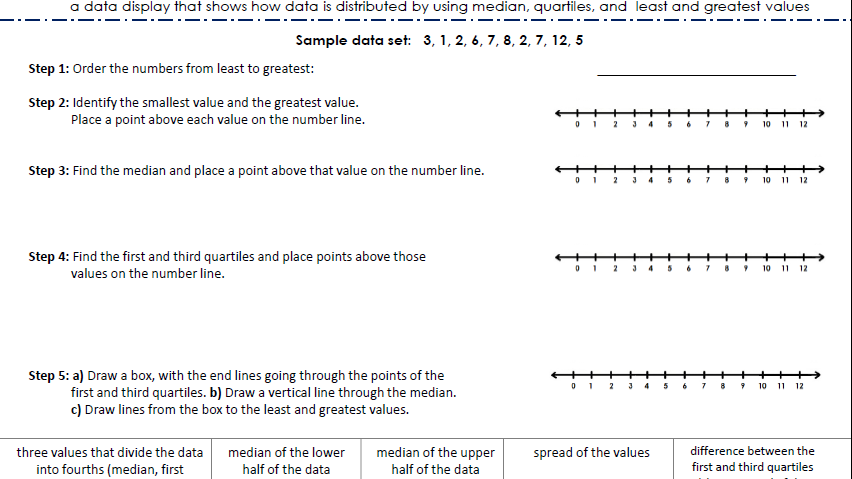In descriptive statistics, the interquartile range (IQR), also called the midspread or middle fifty, is a measure of statistical dispersion, being equal to the difference between the upper and lower quartiles, IQR = Q3 - Q1. In other words, the IQR is the 1st quartile subtracted from the 3rd quartile; these quartiles can be clearly seen on a box plot on the data. It is a trimmed estimator, defined as the 25% trimmed range, and is the most significant basic robust measure of scale.

Use
Unlike total range, the interquartile range has a breakdown point of 50%, and is thus often preferred to the total range.
The IQR is used to build box plots, simple graphical representations of a probability distribution.
For a symmetric distribution (where the median equals the midhinge, the average of the first and third quartiles), half the IQR equals the median absolute deviation (MAD).
The median is the corresponding measure of central tendency.
Identification of outliers (see below).
Box And Whisker Plot Worksheet Grade 6 Video
Examples
Data set in a table
For the data in this table the interquartile range is IQR = 115 - 105 = 10.
Data set in a plain-text box plot
+-----+-+ o * |-------| | |---| +-----+-+ +---+---+---+---+---+---+---+---+---+---+---+---+ number line 0 1 2 3 4 5 6 7 8 9 10 11 12
For the data set in this box plot:
- lower (first) quartile Q1 = 7
- median (second quartile) Q2 = 8.5
- upper (third) quartile Q3 = 9
- interquartile range, IQR = Q3 - Q1 = 2

Interquartile range of distributions
The interquartile range of a continuous distribution can be calculated by integrating the probability density function (which yields the cumulative distribution function -- any other means of calculating the CDF will also work). The lower quartile, Q1, is a number such that integral of the PDF from -? to Q1 equals 0.25, while the upper quartile, Q3, is such a number that the integral from -? to Q3 equals 0.75; in terms of the CDF, the quartiles can be defined as follows:
where CDF-1 is the quantile function.
The interquartile range and median of some common distributions are shown below
Interquartile range test for normality of distribution
The IQR, mean, and standard deviation of a population P can be used in a simple test of whether or not P is normally distributed, or Gaussian. If P is normally distributed, then the standard score of the first quartile, z1, is -0.67, and the standard score of the third quartile, z3, is +0.67. Given mean = X and standard deviation = ? for P, if P is normally distributed, the first quartile
and the third quartile
If the actual values of the first or third quartiles differ substantially from the calculated values, P is not normally distributed.

Interquartile range and outliers
The interquartile range is often used to find outliers in data. Outliers are observations that fall below Q1 - 1.5(IQR) or above Q3 + 1.5(IQR). In a boxplot, the highest and lowest occurring value within this limit are drawn as bar of the whiskers, and the outliers as individual points.
Are You Looking for Products
Here some products related to "Interquartile Range".
Amazon.com : BARSKA 6.5-2..
Pete the Cat: I Love My W..
100 Things That Make Me H..
100 Things That Make Me H..
Get these at Amazon.com* amzn.to is official short URL for Amazon.com, provided by Bitly
Source of the article : here






EmoticonEmoticon